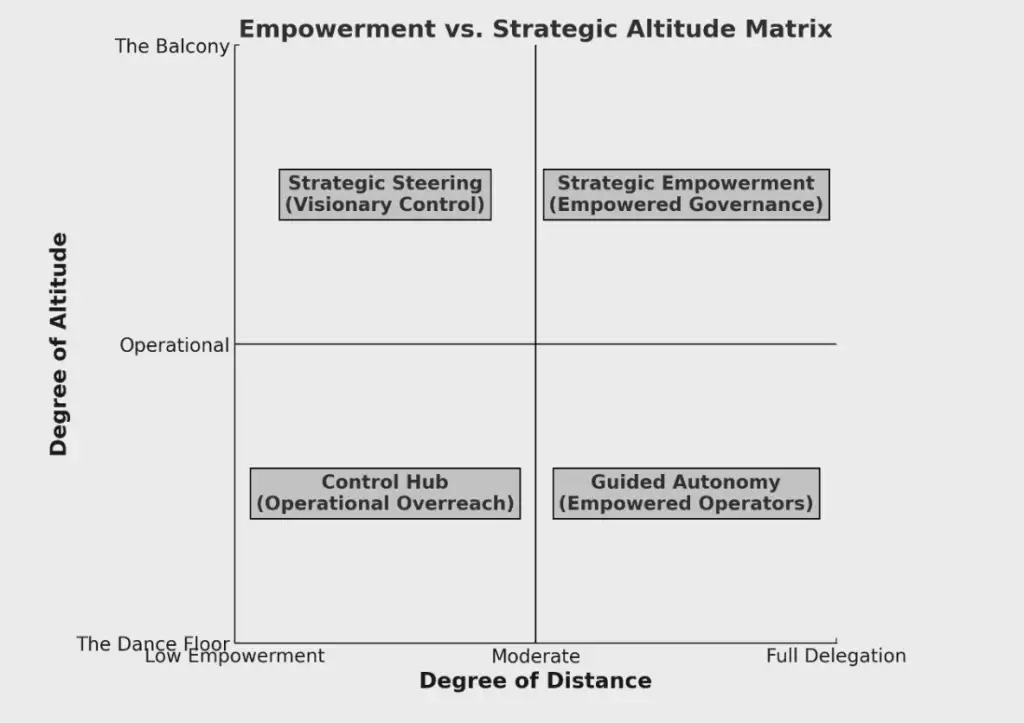This is how you empower your team while maintaining strategic oversight
Effective leadership isn’t a one-size-fits-all endeavor. It requires adaptability, self-awareness, and a deep understanding of when to step in and when to step back. Leaders often struggle to find the right balance between empowering their teams and maintaining strategic oversight. But there’s a way that you can do both. By adopting the practical 2×2 leadership framework that I’ll get into in this article, leaders can assess their approach based on two critical dimensions: Degree of Empowerment and Degree of Strategic Altitude. The leadership quadrants When you map out leadership approaches across these two dimensions, four distinct quadrants emerge. Each quadrant represents a different leadership style, and understanding when and how to apply each can help leaders optimize their impact. Control hub (operational overreach) This quadrant is appropriate when employees lack the necessary skills, experience, or confidence to perform tasks independently. It’s crucial in high-stakes situations that require precision and compliance, like crisis management or regulatory adherence. Leaders should adopt this approach when they’re training new employees or when they need to take immediate corrective action to prevent costly mistakes. Potential pitfalls Overindulgence in this quadrant can lead to micromanagement, which stifles employee creativity and autonomy. When leaders insist on controlling every aspect of a task, employees may feel disengaged and undervalued, leading to high turnover rates and low morale. However, avoiding this quadrant when you genuinely need it can result in poor quality control, increased errors, and project derailment due to a lack of oversight. Maria, a project manager at a fast-growing tech company I’ve consulted with, is leading the rollout of a new software update for a major client. Given the complexity of the project and the tight deadlines, she feels the need to oversee every aspect, from development timelines to QA testing. Despite having a capable team, Maria conducts frequent check-ins, requests detailed reports, and personally reviews code before deployment. Initially, Maria’s approach ensures that the project stays on track and meets the client’s stringent quality standards. But as the project progresses, her team begins to feel micromanaged, leading to frustration and burnout. Experienced developers feel undervalued, and morale begins to decline. Maria realizes that while tight oversight was necessary at the project’s start, gradually transitioning to a more empowering leadership style could have built trust and improved team morale. She implements a phased approach, which allows senior developers to take ownership of specific modules while she shifts focus to higher-level strategic issues. Guided autonomy (empowered operators) This quadrant works best when employees have a solid foundation of skills but still require occasional guidance to refine their capabilities. It’s effective for developing talent and allows employees to build confidence while benefiting from the leader’s strategic input. Leaders should apply this approach when the team needs to complete moderately complex tasks that require periodic support. Potential pitfalls Overindulging in this quadrant can potentially make employees overly dependent on the leader, which slows down their growth and initiative. Leaders might also avoid this quadrant due to discomfort with providing critical feedback, which can allow performance issues to go unchecked. Jason, a sales director, is coaching a group of midlevel sales managers tasked with expanding into a new market. They have a good grasp of sales fundamentals but lack experience in handling high-stakes negotiations with enterprise clients. Jason decides to provide them with structured mentorship, offering periodic guidance while still giving them room to develop their negotiation skills. He schedules biweekly coaching sessions, where he reviews their progress, provides feedback on their approach, and shares best practices. However, Jason struggles to provide direct corrective feedback because he fears it might demotivate them. As a result, some managers continue to struggle with closing deals, leading to missed targets. Jason realizes that empowerment doesn’t mean avoiding difficult conversations. By balancing encouragement with constructive feedback, he can help his team refine their skills without undermining their confidence. He starts incorporating role-playing exercises and clear, actionable feedback into his coaching sessions. Strategic steering (visionary control) This approach is ideal when the organization or team needs clear strategic direction while requiring oversight to ensure alignment with long-term goals. It’s particularly useful during times of change, such as mergers, expansions, or new strategic initiatives. Leaders should engage in strategic steering when they need to provide vision while main

Effective leadership isn’t a one-size-fits-all endeavor. It requires adaptability, self-awareness, and a deep understanding of when to step in and when to step back. Leaders often struggle to find the right balance between empowering their teams and maintaining strategic oversight.
But there’s a way that you can do both. By adopting the practical 2×2 leadership framework that I’ll get into in this article, leaders can assess their approach based on two critical dimensions: Degree of Empowerment and Degree of Strategic Altitude.

The leadership quadrants
When you map out leadership approaches across these two dimensions, four distinct quadrants emerge. Each quadrant represents a different leadership style, and understanding when and how to apply each can help leaders optimize their impact.
Control hub (operational overreach)
This quadrant is appropriate when employees lack the necessary skills, experience, or confidence to perform tasks independently. It’s crucial in high-stakes situations that require precision and compliance, like crisis management or regulatory adherence. Leaders should adopt this approach when they’re training new employees or when they need to take immediate corrective action to prevent costly mistakes.
Potential pitfalls
Overindulgence in this quadrant can lead to micromanagement, which stifles employee creativity and autonomy. When leaders insist on controlling every aspect of a task, employees may feel disengaged and undervalued, leading to high turnover rates and low morale. However, avoiding this quadrant when you genuinely need it can result in poor quality control, increased errors, and project derailment due to a lack of oversight.
Maria, a project manager at a fast-growing tech company I’ve consulted with, is leading the rollout of a new software update for a major client. Given the complexity of the project and the tight deadlines, she feels the need to oversee every aspect, from development timelines to QA testing. Despite having a capable team, Maria conducts frequent check-ins, requests detailed reports, and personally reviews code before deployment.
Initially, Maria’s approach ensures that the project stays on track and meets the client’s stringent quality standards. But as the project progresses, her team begins to feel micromanaged, leading to frustration and burnout. Experienced developers feel undervalued, and morale begins to decline.
Maria realizes that while tight oversight was necessary at the project’s start, gradually transitioning to a more empowering leadership style could have built trust and improved team morale. She implements a phased approach, which allows senior developers to take ownership of specific modules while she shifts focus to higher-level strategic issues.
Guided autonomy (empowered operators)
This quadrant works best when employees have a solid foundation of skills but still require occasional guidance to refine their capabilities. It’s effective for developing talent and allows employees to build confidence while benefiting from the leader’s strategic input. Leaders should apply this approach when the team needs to complete moderately complex tasks that require periodic support.
Potential pitfalls
Overindulging in this quadrant can potentially make employees overly dependent on the leader, which slows down their growth and initiative. Leaders might also avoid this quadrant due to discomfort with providing critical feedback, which can allow performance issues to go unchecked.
Jason, a sales director, is coaching a group of midlevel sales managers tasked with expanding into a new market. They have a good grasp of sales fundamentals but lack experience in handling high-stakes negotiations with enterprise clients. Jason decides to provide them with structured mentorship, offering periodic guidance while still giving them room to develop their negotiation skills.
He schedules biweekly coaching sessions, where he reviews their progress, provides feedback on their approach, and shares best practices. However, Jason struggles to provide direct corrective feedback because he fears it might demotivate them. As a result, some managers continue to struggle with closing deals, leading to missed targets.
Jason realizes that empowerment doesn’t mean avoiding difficult conversations. By balancing encouragement with constructive feedback, he can help his team refine their skills without undermining their confidence. He starts incorporating role-playing exercises and clear, actionable feedback into his coaching sessions.
Strategic steering (visionary control)
This approach is ideal when the organization or team needs clear strategic direction while requiring oversight to ensure alignment with long-term goals. It’s particularly useful during times of change, such as mergers, expansions, or new strategic initiatives. Leaders should engage in strategic steering when they need to provide vision while maintaining control over key decision-making areas.
Potential pitfalls
Overindulgence in strategic thinking might disconnect leaders from ground-level realities, which leaves employees without practical guidance. Avoiding this quadrant may result in a lack of long-term vision, which leads to shortsighted operational decisions.
Emily, the founder of a successful e-commerce startup I’ve coached, wants to expand to international markets. She dedicates most of her time to crafting the company’s long-term strategy and forming partnerships with global distributors. However, in doing so, she becomes detached from day-to-day operations, assuming her management team can handle internal processes.
Over time, operational inefficiencies emerge, with increasing customer complaints about delivery times and product quality. Employees feel directionless as their efforts are not aligned with the founder’s ambitious vision.
Emily realizes the importance of balancing strategic oversight with operational involvement. She implements regular strategy check-ins with her leadership team to ensure alignment between the company’s long-term goals and daily operations, bridging the gap between vision and execution.
Strategic empowerment (empowered governance)
This quadrant works best for high-performing teams that demonstrate consistent results and align well with the organization’s strategic goals. Leaders should utilize this approach when their primary focus is on shaping organizational culture and long-term planning while trusting their teams to handle daily operations effectively. This quadrant is particularly valuable for fostering innovation and employee ownership.
Overreliance on delegation can lead to a lack of awareness of operational challenges, potentially causing misalignment with organizational goals. However, avoiding full delegation altogether might stifle innovation and growth.
Alex, a regional President at a multinational corporation with whom I’ve worked, has built a highly capable leadership team. Trusting their expertise, he adopts a hands-off approach, allowing them full autonomy over department operations. He shifts his focus to high-level industry trends and shapes the organization’s long-term vision.
Initially, this approach fosters a sense of ownership among his managers, and innovation flourishes. However, over time, small inefficiencies begin to accumulate. Without periodic oversight, teams start to work in silos, and communication gaps result in misalignment with company objectives.
Alex learns that he needs to accompany empowerment with structured accountability. He starts to introduce quarterly strategic alignment meetings to ensure all departments remain connected to the broader organizational goals, while maintaining the autonomy that drives innovation.
Great leadership requires a dynamic balance of empowerment and strategic altitude. By understanding and applying this quadrant framework, leaders can better align their leadership style to their team’s needs, which drives both individual and organizational success.
Whether on the dance floor or the balcony, the key is to know when to step in and when to step back.










































































































































































![[The AI Show Episode 146]: Rise of “AI-First” Companies, AI Job Disruption, GPT-4o Update Gets Rolled Back, How Big Consulting Firms Use AI, and Meta AI App](https://www.marketingaiinstitute.com/hubfs/ep%20146%20cover.png)
























































































































![[DEALS] The Premium Python Programming PCEP Certification Prep Bundle (67% off) & Other Deals Up To 98% Off – Offers End Soon!](https://www.javacodegeeks.com/wp-content/uploads/2012/12/jcg-logo.jpg)



















































































































-Mafia-The-Old-Country---The-Initiation-Trailer-00-00-54.png?width=1920&height=1920&fit=bounds&quality=70&format=jpg&auto=webp#)























_Aleksey_Funtap_Alamy.jpg?width=1280&auto=webp&quality=80&disable=upscale#)
_Sergey_Tarasov_Alamy.jpg?width=1280&auto=webp&quality=80&disable=upscale#)















































































































![Apple Developing New Chips for Smart Glasses, Macs, AI Servers [Report]](https://www.iclarified.com/images/news/97269/97269/97269-640.jpg)
![Apple Shares New Mother's Day Ad: 'A Gift for Mom' [Video]](https://www.iclarified.com/images/news/97267/97267/97267-640.jpg)
![Apple Shares Official Trailer for 'Stick' Starring Owen Wilson [Video]](https://www.iclarified.com/images/news/97264/97264/97264-640.jpg)

































































































